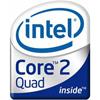|
Intel Q9650 3.00GHz Quad Core Processor
A Closer Look:
The Intel Q9650 came packaged in the OEM packaging since we were testing it, so we won't bother showing you a plain white box. As usual, the processor comes with a standard LGA775 Intel heatsink with thermal compound pre-applied. By LGA775, we're referring to the socket of the motherboard, with the processor having 775 picson the bottom. Most processors have the model stamped on top, but our engineering sample simply tells us that it was made in Malaysia!
Another thing to note about the Q9650 is two new Intel technologies. The Q9650 has Intel TXT (Trusted Execution Technology), which the Q6700 does not have. This can be explained by Intel.com:
"By providing a hardware-based security foundation, Intel TXT provides greater protection for information that is used and stored on the business PC. A key aspect of that protection is the provision of an isolated execution environment and associated sections of memory where operations can be conducted on sensitive data, invisibly to the rest of the system. Likewise, Intel TXT provides for a sealed portion of storage where sensitive data such as encryption keys can be kept, helping to shield them from being compromised during an attack by malicious code. To make sure that code is, in fact, executing in this protected environment, attestation mechanisms verify that the system has correctly invoked Intel TXT."
The Q9650 also has Intel SIPP (Stable Image Platform Program) Technology. SIPP Technology is not present in the Q6700 processor, and can also be explained by the following except from Intel.com:
"Intel SIPP aligns and stabilizes key Intel platform components to enable a more predictable annual transition from one generation of technology to the next. Intel SIPP enhances software stability by ensuring no changes to key platform components or drivers for at least 15 months from introduction. This allows for a 3-month qualification period and a 12-month deployment cycle."
Comparison:
We compared the Q9650 to our previous Intel Quad, the Q6700. Both of them are LGA775 Quad-cores, but there are a few differences you should know about for our testing section. The differences in these processors are shown in the table below:
| Model: | Q6700 |
Q9650 |
| CPU Speed: | 2.66 GHz |
3.00 GHz |
| Bus Speed: | 1066 MHz |
1333 MHz |
| L2 Cache Size: | 8 MB |
12 MB |
| Manufacturing Technology: | 65 nm |
45 nm |
| Bus/Core Ratio: | 10.0 |
9.0 |
| VID Voltage Range: | 0.85V – 1.5V |
0.85V – 1.3625V |
| Core Stepping: | G0 |
E0 |
| Thermal Design Power: | 95W |
95W |
| sSpec Number: | SLACQ |
SLB8W |
| Intstruction Set: | SSE3 |
SSE4 |
A direct comparison can be seen in Intel.com here.
All testing of the Q9650 will be compared with the Q6700, even though the CPU speeds differ. The Q9650 just so happens to sit at the top of the Core 2 Quad line, so the Q6700 is the closest thing the Q9650 has to the 65 nm generation of the Intel processors. We will be testing the Q6700 at its 2.66GHz speed with a 1066FSB and a 10x multiplier, as well as 2.66GHz with a 1333FSB and an 8x multiplier. This should provide a decent comparison.

REALTIME PRICING







